Ginger Simpson's Blog, page 74
September 29, 2014
ARE YOUR CHARACTERS SWEARING? BY RITA KARNOPP
I must admit – I’m on the fence about swearing. It seems more and more people are swearing and I’m seeing it more in books. So what are the rules – or are there any?
I rarely swear myself (and I never say the ‘F’ word), and if I must swear it seems my Polish flies before I’ll actually cuss in English. That’s because swearing is offensive. Yet, our characters must be themselves . . . right?
I think I shocked my family and most likely my readers when I had a female character using the ‘F’ word in No Ordinary Killer. It wasn’t natural nor was it easy for me to use such words. But I don’t think we always have a choice.
If our character naturally swears – you have to write it. Fighting your character’s natural personality just won’t work.I cringe when I hear the ‘F’ word and as a parent- I hate it even more. But, if our characters were all perfect, polite, and saintly we’d have a pretty boring book. You can balance the scales with bad language and refrain from being crude.
If your character swears naturally . . . if it feels natural . . . and in character, I say he should swear. Use these words sparingly and when he’s making a point.
The bottom line is your readers will accept swearing if your character(s) credibly utter them.
IA agent, Dallas Fortune, is investigating Cooper Reynolds. Although there is more incriminating evidence proving his guilt than innocence, she instinctively believes he is being framed. Together they fight to stay alive while unraveling the clues the killer leaves behind . . . with the hope they'll discover his identity before Cooper is sent to prison for six murders.
I rarely swear myself (and I never say the ‘F’ word), and if I must swear it seems my Polish flies before I’ll actually cuss in English. That’s because swearing is offensive. Yet, our characters must be themselves . . . right?
I think I shocked my family and most likely my readers when I had a female character using the ‘F’ word in No Ordinary Killer. It wasn’t natural nor was it easy for me to use such words. But I don’t think we always have a choice.
If our character naturally swears – you have to write it. Fighting your character’s natural personality just won’t work.I cringe when I hear the ‘F’ word and as a parent- I hate it even more. But, if our characters were all perfect, polite, and saintly we’d have a pretty boring book. You can balance the scales with bad language and refrain from being crude.

If your character swears naturally . . . if it feels natural . . . and in character, I say he should swear. Use these words sparingly and when he’s making a point.
The bottom line is your readers will accept swearing if your character(s) credibly utter them.
IA agent, Dallas Fortune, is investigating Cooper Reynolds. Although there is more incriminating evidence proving his guilt than innocence, she instinctively believes he is being framed. Together they fight to stay alive while unraveling the clues the killer leaves behind . . . with the hope they'll discover his identity before Cooper is sent to prison for six murders.
Published on September 29, 2014 01:00
September 28, 2014
Welcome Brenda Whiteside and her Rafflescopter Giveaway #contest
 WHERE DO THOSE IDEAS COME FROM?
WHERE DO THOSE IDEAS COME FROM?Thanks so much for having me today on Dishin’ It Out. I’m excited to have your readers learn about my latest release, The Art of Love and Murder, the first book in my Love and Murder series. I hope everyone enters the Rafflecopter drawing for a tote bag of items that relate to the book. The more you enter, the more chances you have to win. This link will direct you to all the blogs on my tour: http://brendawhiteside.blogspot.com/p/contests-and-give-ways.html
Stories come to me from a phrase, a song, people I know or any other number of ways. This isn’t unique to me. Writers find inspiration in many different ways, at times not even recognizing where or how the idea came to them.
My Love and Murder series started a bit differently this time. There was no zing of inspiration from something I overheard, a phrase I read or a song on the radio. I purposely set out to write a series – and I wanted suspense and murder to be part of it. My husband is an avid reader of suspense. One night at dinner, I announced my intentions and asked for some brainstorming help. He’s a big supporter, but I’ve never asked for input. Once I described my heroine and steered him away from his first suggestions involving the CIA, we rolled along. He’s been instrumental in helping me brainstorm the first three books – The Art of Love and Murder , Southwest of Love and Murder and The Legacy of Love and Murder .
Books four and five are still vague ideas, but I know who I can count on to help me brainstorm.
Blurb for The Art of Love and Murder :
Lacy Dahl never questioned her past until the deaths of her adoptive parents and her husband. A husband who wasn't what he seemed. Her research uncovers secrets about the mother she never knew; secrets that dispute the identity of her father and threaten her life.
Sheriff Chance Meadowlark is still haunted by the murder of his wife and the revenge he unleashed in the name of justice. When he meets Lacy he is determined not to become involved, but their pasts may make that impossible. As they move closer to the truth, saving Lacy may be his only salvation.
Lacy begins to think the present is more important than her past...until Chance's connection to her mother and a murder spin her deeper into danger and further from love. Will the truth destroy Lacy and Chance or will it be the answer that frees them?
 Excerpt for
The Art of Love and Murder
:
Excerpt for
The Art of Love and Murder
:Lacy quickened her pace. The footsteps behind her did the same. As fast as her feet touched the bricks, her heart beat twice that speed. If only she could clear the narrow alley, step onto the lit sidewalk… Like a magnet, the street light pulled her forward, and she lunged out of the darkness. Her hand slammed to her chest. After a hard intake of breath and a fast exhale, she cast a furtive glance over her shoulder. With the strap of her purse in a tight fist against her breast, she whirled around to cover the last block at a trot.
She didn’t see him until too late.
As if she’d hit a cement wall, she careened off balance, but his hands grabbed her shoulders keeping her upright. She gasped and reared back and out of his arms. Her fisted purse became a weapon as she hurled a defensive blow to his chest. Her knee came up, landing a jab to his thigh. “Ehhh,” she cried out from the pain of contact.
“Lady, I’m not going to hurt you.” He held his ground and loomed over her, his hands at his chest fending off the swing of her fist.
Her vision filled with the imposing figure, and a chill shivered her body. Run screamed in her head. This time the swing of her purse missed her target when she turned to escape. His hand caught her arm and pulled her close.
“Help, help me!” Her voice came high and hysterical.
“I am trying to help.”
Both hands gripped her shoulders now, and her feet came partly off the ground, forcing her to look into his face.
“What’s wrong? Are you in trouble?”
Her head swung side to side, but the empty street and sidewalks could have been a ghost town. In the distance, a jazzy tune drifted through the air with voices too far away to help. She gulped.
He waited.
Buy Links:
TWRP http://www.wildrosepublishing.com/maincatalog_v151/index.php?main_page=index&manufacturers_id=726&zenid=d06039eba05c5b010fb8a707eecd4259
Amazon http://www.amazon.com/Art-Love-Murder-Brenda-Whiteside-ebook/dp/B00K0N0Y6M/ref=sr_1_1?s=books&ie=UTF8&qid=1399254400&sr=1-1&keywords=the+art+of+love+and+murder
ARe https://www.allromanceebooks.com/product-theartofloveandmurder-1496046-149.html
KOBO http://store.kobobooks.com/en-US/ebook/the-art-of-love-and-murder
About the Author:
Brenda spends most of her time writing stories of discovery and love. The rest of her time is spent tending vegetables on the small family farm she shares with her husband, son, daughter-in-law and granddaughter. Together, they’ve embraced an age-old lifestyle that has been mostly lost in the United States - multiple generations living under one roof, who share the workload, follow their individual dreams and reap the benefits of combined talents.
Although she didn’t start out to write romance, she’s found all good stories involve complicated human relationships. She’s also found no matter a person’s age, a new discovery is right around every corner. Whether humorous or serious, straight contemporary or mystery, all her books revolve around those two facts.
Visit Brenda at www.brendawhiteside.com. Or on FaceBook: www.facebook.com/BrendaWhitesideAuthor
Twitter: https://twitter.com/#!/brendawhitesid2 She blogs on the 9th and 24th of every month at http://rosesofprose.blogspot.com She blogs about writing and prairie life at http://brendawhiteside.blogspot.com/ a Rafflecopter giveaway
Published on September 28, 2014 00:00
September 27, 2014
Round Robin Blog with Ginger Simpson #RndRobin0914
 Rhobin Courtright provides such interesting topics for our monthly posts, and this month is no different.
Rhobin Courtright provides such interesting topics for our monthly posts, and this month is no different. September's topic is about abandoned places. Do you have abandoned places near you that itch your curiosity about what happened and why? Does your imagination take over? Are these places haunted? What stories do you imagine?
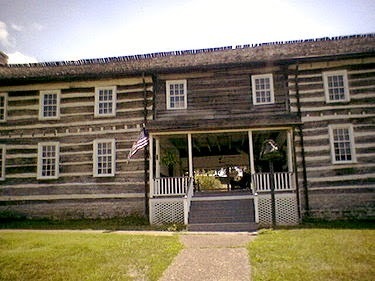
I live on a street named after a Tennessee historical site, Wynnewood House. The building of this beautiful two-story log structure was started in 1828 and probably not finished until a year or so later as a stage stop and mineral springs for those traveling the Avery Trace, at the time, the main east-west road across the state. The complexity of the architecture surely took quite a while due to the size of the building. Because of my interest in writing western historical novels, I'm fascinated by this structure that has become an historic museum of sorts. Guided tours open to the public, allow people a glimpse back in time by perusing the site. I've borrowed the description from a blog that appears to have become defunct...Kenny's Sideshow describes Wynnewood:
"The inn was built of materials plentifully available on the site. The foundation walls, which raised the logs and other woodwork safely above the damaging effects of surface water and moisture, were formed of limestone blocks quarried from the adjacent hillside. The same material was used to build the six original chimneys, five of which are still standing. Sturdy hardwood logs - many as long as thirty-two feet and all cut from nearby trees - were squared to 8” x 16”, notched and put in place on the foundation for the walls of the two story building. Hand-hewn beams and joists whose ends rested on the foundation supported the first story. At the second floor level supporting joists were mortised directly into the log walls. Ceiling joists for the second floor served to tie the roof rafter sstructuretogether as well as to support the ceiling. The roof, latticed with wide boards, was originally covered with hand-split wood shingles. When acquired by the State in 1971, the roofing was asphalt shingles placed ca. 1936. When replaced in 1995, the roof was restored to hand-split wood shingles matching those removed in 1936.
The main building of the inn, approximately 110’ x 21’, contained ten rooms: five on each of the two floors. There were fireplaces in eight of the ten rooms. On the first floor a central open hallway or “dogtrot” led from the front steps to the back porch or galley which extended nearly the full length of the rear of the building. All rooms on the first floor opened onto the dogtrot or the gallery. Originally there were no rooms with connecting passageways. Rooms on the second floor were reached by one of the two stairways, the principal one rising from the dogtrot. The second ascends from the gallery at a point one room away from the west end of the building. The large room at the east end of the second floor, the size of the two first floor rooms beneath it, was used at one time as a meeting room for the local Masonic lodge. At other times it was used as a public sleeping room for male overnight guests of the inn. The original roof over the gallery was at the level of the eaves of the second floor. In 1899 it was lowered to its present first floor level.
The interior walls of the five first floor rooms were at first unfinished but later plastered. The plaster finish was applied in late 1836 is Almira Wynne was able to heed her husband’s written instruction from Natchez, November 4, 1836 suggesting that she “brave the difficulties” and have it finished before bad weather. Sometime since, plaster has been applied to the walls of the three westernmost rooms on the second floor. The large upstairs room at the east end was left with the logs exposed.A large kitchen, approximately 20 feet square, with a massive stone fireplace was located in a story and half log house connected by its roof structure to the west end of the main building and separated by another dogtrot. It is thought to have been a part of the original construction of the inn. The kitchen floor was some six or seven steps lower than the floor of the main building. Five steps led down from the kitchen level into the spacious stone-walled cellar located beneath the two westernmost rooms of the inn. Separate open-riser stairs connected the kitchen to the room above it.
A two-story annex has formed an ell-type extension southward from the main building since it was connected to the inn in 1899. The log portion of this unit, approximately 20x20, is located at the south end of the ell and appears to have been built sometime before the inn. It is of two stories and originally was served by a stone fireplace and chimney, both of which were later removed. All of the logs used were of cedar; a fact that clearly sets it apart from the other buildings in which the use of cedar logs was consistently avoided. Differences in the squaring of the logs and the corner notching are such that suggest an earlier stage of construction. Could this have been the “comfortable cabin” and/or “workshop,” the only two structures mentioned in the published court notice of sale of 300 acres to settle General Winchester’s estate in 1829? On this point, no firm facts are available. Connection of the log house to the inn by board and batten walls created additional enclosed space that has since been used as a dining room.
Located about fifty feet south and west of the annex is the original smokehouse. The details of its log construction seem to match the inn in every particular and strongly imply that it was built at the same time that the inn was created.
Perhaps forty feet southeast of the inn is a log cottage containing a single room with a large stone fireplace. This unit is of the same period as the original construction. It was used for many years sa office and living quarters for the community medical doctor. In later years it was rented as a summer cottage and its accomodations carried the highest rates charged. In other times it was variously used as the Wynne family’s bachelor quarters and as a schoolroom.
As an inn, mineral springs resort, and spa, Castalian Springs saw two major periods of operation. The first lasted from 1830 until 1861, the second from 1899 until 1914. Though commercial guests were not sought between 1861 and 1899, the custom of taking local boarders did continue in this period."
Sadly, in 2008, an E3 tornado severely damaged Wynnewood house It has since been rebuilt and reopened, but I can't help but imagine that Mother Nature drove away the "spirits" I imagine still dwelled there. If I could, I'd like to time-travel back to 1830 and view the hustle and bustle of travelers as they sought rest and relief from long stagecoach rides across bumpy and dusty roads. If you listen really hard, you can still hear their "ahhh," as they slip into the relaxing mineral springs.
Here's a picture of Wynnewood after the tornado. You can see the original wooden structure amidst the damage.
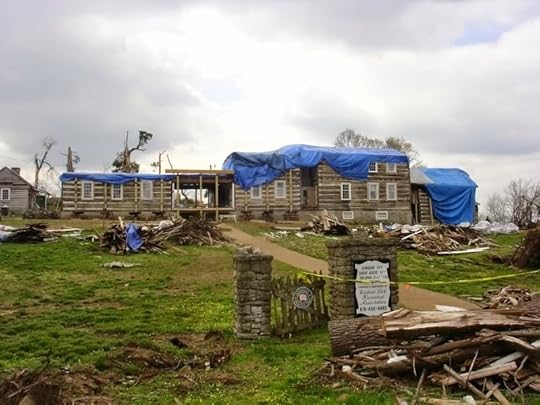

Now hop on over to the sites of the other participants and see how they've addressed today' topic:
Skye Taylor
Helena Fairfax
Connie Vines
Rachael Kosnski
Marci Baun
Anne Stenhouse
Judith Copek
A.J. Maguire
Beverley Bateman
Rhobin Courtright
Published on September 27, 2014 12:14
September 26, 2014
Round Robin Blog with Ginger Simpso n #RndRobin0914
 Rhobin Courtright provides such interesting topics for our monthly posts, and this month is no different.
Rhobin Courtright provides such interesting topics for our monthly posts, and this month is no different. September's topic is about abandoned places. Do you have abandoned places near you that itch your curiosity about what happened and why? Does your imagination take over? Are these places haunted? What stories do you imagine?
[image error] Rebuilt Version
I live on a street named after a Tennessee historical site, Wynnewood House. The building of this beautiful two-story log structure was started in 1828 and probably not finished until a year or so later as a stage stop and mineral springs for those traveling the Avery Trace, at the time, the main east-west road across the state. The complexity of the architecture surely took quite a while due to the size of the building. Because of my interest in writing western historical novels, I'm fascinated by this structure that has become an historic museum of sorts. Guided tours open to the public, allow people a glimpse back in time by perusing the site. I've borrowed the description from a blog that appears to have become defunct...Kenny's Sideshow describes Wynnewood:
"The inn was built of materials plentifully available on the site. The foundation walls, which raised the logs and other woodwork safely above the damaging effects of surface water and moisture, were formed of limestone blocks quarried from the adjacent hillside. The same material was used to build the six original chimneys, five of which are still standing. Sturdy hardwood logs - many as long as thirty-two feet and all cut from nearby trees - were squared to 8” x 16”, notched and put in place on the foundation for the walls of the two story building. Hand-hewn beams and joists whose ends rested on the foundation supported the first story. At the second floor level supporting joists were mortised directly into the log walls. Ceiling joists for the second floor served to tie the roof rafter sstructuretogether as well as to support the ceiling. The roof, latticed with wide boards, was originally covered with hand-split wood shingles. When acquired by the State in 1971, the roofing was asphalt shingles placed ca. 1936. When replaced in 1995, the roof was restored to hand-split wood shingles matching those removed in 1936.
The main building of the inn, approximately 110’ x 21’, contained ten rooms: five on each of the two floors. There were fireplaces in eight of the ten rooms. On the first floor a central open hallway or “dogtrot” led from the front steps to the back porch or galley which extended nearly the full length of the rear of the building. All rooms on the first floor opened onto the dogtrot or the gallery. Originally there were no rooms with connecting passageways. Rooms on the second floor were reached by one of the two stairways, the principal one rising from the dogtrot. The second ascends from the gallery at a point one room away from the west end of the building. The large room at the east end of the second floor, the size of the two first floor rooms beneath it, was used at one time as a meeting room for the local Masonic lodge. At other times it was used as a public sleeping room for male overnight guests of the inn. The original roof over the gallery was at the level of the eaves of the second floor. In 1899 it was lowered to its present first floor level.
The interior walls of the five first floor rooms were at first unfinished but later plastered. The plaster finish was applied in late 1836 is Almira Wynne was able to heed her husband’s written instruction from Natchez, November 4, 1836 suggesting that she “brave the difficulties” and have it finished before bad weather. Sometime since, plaster has been applied to the walls of the three westernmost rooms on the second floor. The large upstairs room at the east end was left with the logs exposed.A large kitchen, approximately 20 feet square, with a massive stone fireplace was located in a story and half log house connected by its roof structure to the west end of the main building and separated by another dogtrot. It is thought to have been a part of the original construction of the inn. The kitchen floor was some six or seven steps lower than the floor of the main building. Five steps led down from the kitchen level into the spacious stone-walled cellar located beneath the two westernmost rooms of the inn. Separate open-riser stairs connected the kitchen to the room above it.
A two-story annex has formed an ell-type extension southward from the main building since it was connected to the inn in 1899. The log portion of this unit, approximately 20x20, is located at the south end of the ell and appears to have been built sometime before the inn. It is of two stories and originally was served by a stone fireplace and chimney, both of which were later removed. All of the logs used were of cedar; a fact that clearly sets it apart from the other buildings in which the use of cedar logs was consistently avoided. Differences in the squaring of the logs and the corner notching are such that suggest an earlier stage of construction. Could this have been the “comfortable cabin” and/or “workshop,” the only two structures mentioned in the published court notice of sale of 300 acres to settle General Winchester’s estate in 1829? On this point, no firm facts are available. Connection of the log house to the inn by board and batten walls created additional enclosed space that has since been used as a dining room.
Located about fifty feet south and west of the annex is the original smokehouse. The details of its log construction seem to match the inn in every particular and strongly imply that it was built at the same time that the inn was created.
Perhaps forty feet southeast of the inn is a log cottage containing a single room with a large stone fireplace. This unit is of the same period as the original construction. It was used for many years sa office and living quarters for the community medical doctor. In later years it was rented as a summer cottage and its accomodations carried the highest rates charged. In other times it was variously used as the Wynne family’s bachelor quarters and as a schoolroom.
As an inn, mineral springs resort, and spa, Castalian Springs saw two major periods of operation. The first lasted from 1830 until 1861, the second from 1899 until 1914. Though commercial guests were not sought between 1861 and 1899, the custom of taking local boarders did continue in this period."
Sadly, in 2008, an E3 tornado severely damaged Wynnewood house It has since been rebuilt and reopened, but I can't help but imagine that Mother Nature drove away the "spirits" I imagine still dwelled there. If I could, I'd like to time-travel back to 1830 and view the hustle and bustle of travelers as they sought rest and relief from long stagecoach rides across bumpy and dusty roads. If you listen really hard, you can still hear their "ahhh," as they slip into the relaxing mineral springs.
Here's a picture of Wynnewood after the tornado. You can see the original wooden structure amidst the damage.


Now hop on over to the sites of the other participants and see how they've addressed today' topic: kye Skye Taylor
Helena Fairfax
Connie Vines
Rachael Kosnski
Marci Baun
Anne Stenhouse
Judith Copek
A.J. Maguire
Beverley Bateman
Rhobin Courtright
Published on September 26, 2014 23:30
September 25, 2014
Friday Freebits with Ginger #frifreebits
 It's Friday again. Boy, don't this weeks fly by? Today, another installment from
Destiny's Bride
. Hope you enjoy it. It's still September, so don't forget Books We Love's September Select Sale where a number of books are only ninety-nine cents the entire month.
Destiny's Bride
is among them.
It's Friday again. Boy, don't this weeks fly by? Today, another installment from
Destiny's Bride
. Hope you enjoy it. It's still September, so don't forget Books We Love's September Select Sale where a number of books are only ninety-nine cents the entire month.
Destiny's Bride
is among them.***
She (Cecile) kicked a splintered piece of wood and
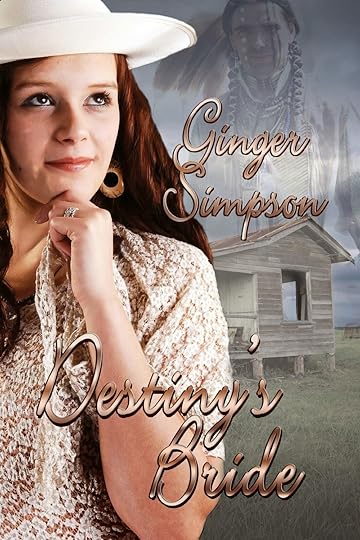 sent it flying. Why hadn't she asked him more abut himself? Where was he from or had he ever visited before? Had he come to town and she just didn't recall? No way! She'd certainly remember someone with his good looks. With any luck, maybe he'd stay in town long enough to come to the upcoming Spring Fling. Her heart quickened again.
sent it flying. Why hadn't she asked him more abut himself? Where was he from or had he ever visited before? Had he come to town and she just didn't recall? No way! She'd certainly remember someone with his good looks. With any luck, maybe he'd stay in town long enough to come to the upcoming Spring Fling. Her heart quickened again.She had never actually met his Aunt May, but knew her by sight. She was a short, rather plump woman with silver gray hair usually pulled back into a bun. They had exchanged smiles and pleasantries across the aisles of the mercantile on several occasions, but Cecile's father referred to the woman's boarding house as being on the "wrong side of the tracks." He forbade Cecile to step foot into that area; warned over and over again it was no place for a respectable young woman to venture. Cowpokes and drifters traveling through Silver City frequented the saloons nearby. Sometimes her father was far too judgmental.
So, how could she manage to run into Walt again? A mental picture of him flashed through her mind, and determination drove her thoughts.
"Afternoon, Miz Cecile," a passing resident called, drawing her from her thoughts.
She gave a quick nod then grimaced. Afternoon? Another face emerged in her mind's eye--her father's, and he most likely wasn't happy. Here she dawdled along thinking about Walt and her father still hadn't eaten. He'd be furious. She hastened her steps.
Her mother met her at the door, her brow raised. Eyeing the stains on Cecile's dress, Mrs. Palmer shook her head. "My goodness what happened to you? You're a mess."
***
See, a handsome man can make you lose your mind. First Cecile tripped and spilled her father's lunch tray all over herself, and now she's just dawdling while her Pa is starving and probably wondering what the heck happened. He's not the most patient man around. *lol* Thankfully, mother rescues her daughter and sends her back with a second tray. More to come next week, but in the meantime, you can always get your own copy for a mere 99 cents via my amazon author's page.
Published on September 25, 2014 23:00
EVERY WORD YOU WRITE BY RITA KARNOPP #writingtips
 Every word you write is important. That doesn’t mean you have to write every word possible. Writing ‘tight’ is as important as pacing and freshness. A short sentence is more effective than a paragraph saying the same thing. Get to the point!
Every word you write is important. That doesn’t mean you have to write every word possible. Writing ‘tight’ is as important as pacing and freshness. A short sentence is more effective than a paragraph saying the same thing. Get to the point!I know that when we naturally talk with others we have a tendency to wander here and there in conversation. But, don’t write your book that way. Let your characters talk - just don’t let them ramble on-and-on.
blue in color
Editing is the time to be thinking about cutting redundant words (surprised and startled are the same thing) and the over explained paragraphs, plus meaningless dialog.
Don’t pepper your work with ‘big words’ because you love the English language. Another area to be careful of is the professional and technical language you’re used to, but most likely your reader isn’t. Write so your reader will understand. Don’t try to teach them your expert or procedural language either.
When editing, look for sentences that can be switched around and shortened. You’d be amazed how tight your writing will become.
Detach yourself emotionally from your words. That’s big. I hate to delete a flowing, brilliant sentence. But if it doesn’t sound like my character – I’ll have to cut that sentence. It’s not easy – but if it makes my book better, I’m willing to cut it out!
Rely on the power of a single well-chosen word and trust it to do its job. What are some key tips to writing tight?
Remove redundant modifiers. Say what? Yep, they’re part of our every-day language, yet not necessary. Here are some commonly used redundant modifiers. I’m sure once you read them, you’ll have many more to add to the list.
sat down true facts end result sudden crisis full and complete terrible tragedy kind of each individual hopes and desires free gift first and foremost important essentials basic and fundamental consensus of opinion each and every various differences true and accurate past history completely finished final outcome
When you’re editing, watch for repeat meanings of words and delete them. Also be aware of redundant word phrasing.
This is the last and final call for mystery writer interviews.Revise: This is the final call for mystery writer interviews.
Also watch for redundant categories. Certain words suggest a category.
shiny is an appearance large in sizebright in color round in shapeperiod in time at an early time
A final tip you can do to catch redundant modifiers is to read your book out loud. It’s amazing what your ears will hear - that your eyes don’t see! You can cut redundancies and tighten your story.
“Let’s tighten that last paragraph!”
A final tip? Read your story aloud. You’ll hear those redundant modifiers, cut them and tighten your writing.
Published on September 25, 2014 01:00
September 24, 2014
A Page Straight From J. E. Lowder - #apagestraightfrom
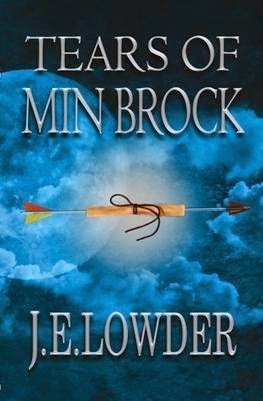 Tears of Min Brock (Epic YA Fantasy)byJ.E. Lowder Gundin did not remember how he got to the middle of Hetherlinn. Nor did he recall Quinn yanking him from cottage Number 7 or how they made their way past screaming women and terrified children. Even the thundering hooves of their enemy entering Hetherlinn did not stir him from his delusions.It was no wonder that he stared glassy-eyed at the Ebonite cavalry that encircled the villagers. Wihin his mind, he was back in the Dark War, leading a charge of men toward an Ebonite stronghold. This dissolved into a vignette in which he sat with his men around a campfire sharing pipes and stories. Amidst his fantasy, he felt the ground shake. He tried to make sense of it, but could not, for the rumbling was coming from somewhere beyond his illusions. The ground shook again followed by what sounded like a thunderclap. The foreign effects became shards of recall that pierced his fantasyworld like lances. He battled to discern fact from myth, truth from fantasy. He fought to regain control of his thoughts and center them once again in reality, something he had not done since the Dark War.As if awakening from a dream, he found that he was with the other villagers near the fire. Some were ghostly pale, others wept, but he had no idea why. Gundin continued to piece his strange experience together, trying to make sense of the earthquake and thunder. Memories flashed like lightning, and within the heat of its light, he remembed the March of Reeds shaking the ground followed by the Ebonite cavalry thundering out of Hetherlinn.A man moaned. A quick glance at the ground revealed Quinn wounded.
Tears of Min Brock (Epic YA Fantasy)byJ.E. Lowder Gundin did not remember how he got to the middle of Hetherlinn. Nor did he recall Quinn yanking him from cottage Number 7 or how they made their way past screaming women and terrified children. Even the thundering hooves of their enemy entering Hetherlinn did not stir him from his delusions.It was no wonder that he stared glassy-eyed at the Ebonite cavalry that encircled the villagers. Wihin his mind, he was back in the Dark War, leading a charge of men toward an Ebonite stronghold. This dissolved into a vignette in which he sat with his men around a campfire sharing pipes and stories. Amidst his fantasy, he felt the ground shake. He tried to make sense of it, but could not, for the rumbling was coming from somewhere beyond his illusions. The ground shook again followed by what sounded like a thunderclap. The foreign effects became shards of recall that pierced his fantasyworld like lances. He battled to discern fact from myth, truth from fantasy. He fought to regain control of his thoughts and center them once again in reality, something he had not done since the Dark War.As if awakening from a dream, he found that he was with the other villagers near the fire. Some were ghostly pale, others wept, but he had no idea why. Gundin continued to piece his strange experience together, trying to make sense of the earthquake and thunder. Memories flashed like lightning, and within the heat of its light, he remembed the March of Reeds shaking the ground followed by the Ebonite cavalry thundering out of Hetherlinn.A man moaned. A quick glance at the ground revealed Quinn wounded.Buy Link
Published on September 24, 2014 00:00
September 23, 2014
WORLD OF MOTIVATION BY JASON GRACIA -MOTIVATION123.COM (hi-jacked)
 In the world of motivation, tens of thousands of words have been thought up, written down, and spoken out on the subject.
In the world of motivation, tens of thousands of words have been thought up, written down, and spoken out on the subject.But it actually comes down to just four.
What is your Why?
That's it. That's the source of all motivation, no matter the hope, goal, or dream.
When you know your Why--the reason you are after what you're after--you have the engine of action at your fingertips.
Many of my readers and clients know what they want; they've spent years crafting the vision in their minds.
But when I ask why they want it, few know. Hence their lack of motivation.
I want you to tap into your Why, not the surface ideas such as more money or less weight, but the core reasons beneath your needs and wants.
What are you truly after? What will success bring into your life? How will the future change for the best after you've achieved your goal?
What is your Why?
Published on September 23, 2014 01:00
September 22, 2014
SUPPORTING CHARACTERS BY RITA KARNOPP #supportingcharacters
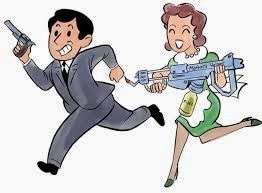 There is nothing more endearing than a great supporting character. I think of the movie Sahara where Matthew McConaughey’s (Dirk) humorous side-kick Steve Zahn (Al) added so much to the story, you loved him almost as much as you did the lead. We all recognize Scotland Yard Inspector, Holmes and his incredible sidekick Watson.
There is nothing more endearing than a great supporting character. I think of the movie Sahara where Matthew McConaughey’s (Dirk) humorous side-kick Steve Zahn (Al) added so much to the story, you loved him almost as much as you did the lead. We all recognize Scotland Yard Inspector, Holmes and his incredible sidekick Watson. Supporting characters are the sounding board, the foil, the spark that allows the leading character to share information with the reader. Don’t you just hate it when characters talk to themselves? What a cheesy way to explain what’s happening in a scene or to express internal conflict.
Supporting characters create balance and sometimes unbalance in a story. A good use for a sidekick is the friend or co-worker who doesn’t let the main character(s) got too full of himself, or go over the edge and murder the man who killed his wife. The counterbalance supporting character, like a wife or child, will show the hardened policeman in a different light.
I’ve heard it say, ‘sidekicks are the yin to the protagonists’ yang.’ That works for me and reminds me the main character(s) need someone to bounce their concerns off, to give comic relief, or to be that one person that will make your story believable. When creating sidekicks just think opposites and you’ll be right on track.
You can also choose sidekicks that are annoying, tormenting, and generally a pain in the butt. What kind of characters are these? Say the over-protective and caring mother. How about the co-worker who is jealous and is constantly trying to belittle the protagonist?
Conflict keeps your story alive and supporting characters can provide all sorts of stimulating or multidimensional problems that can thwart, obfuscate, and even mystify the protagonist.
In many instances your supporting character is also the adversary who needs convincing and even support throughout the story. With a challenger or rival in the story, the sleuth has opportunities to dispute, struggle and typically reveal his grit, cleverness, resourcefulness, cunning, and also skill.
So who is the supporting character? He/she can be anyone in your main character’s life; wife, a friend, neighbor, co-worker, bartender, even pet. Your supporting character adds dimension to the story by adding more threat or risk, and maybe even the possibility of becoming a suspect.
Just like main characters, supporting characters come with flaws and baggage of their own. It your protagonist has children, who is taking care of them while he/she is out searching for a killer? Again, if you have a pet- they have to be fed and watered as well as taken out for potty breaks. An invalid mother needs a caretaker.If your supporting character is important to the story, make the reader believably care or hate them, but don’t stereotype them to the point of boring or making them obvious players. Flesh out their characters so they’re integral to the story as well.
Supporting characters should never become as important as the protagonist. They are supporting cast – always keep that in mind. They are there to compliment, not clog the story up with their issues and opinions.
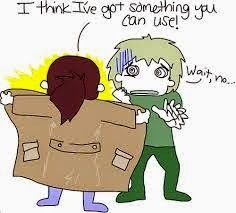 Minor characters should never make a splash when introduced into your story. Minor characters are just that. You don’t have to introduce the waitress or the bar tender if they play no larger role in the story than to serve food or drinks. They are in your story to add texture and realism and nothing more.
Minor characters should never make a splash when introduced into your story. Minor characters are just that. You don’t have to introduce the waitress or the bar tender if they play no larger role in the story than to serve food or drinks. They are in your story to add texture and realism and nothing more.Remember, your supporting characters are just that – supporting the main character(s) to facilitate the plot and keep the reader turning those pages with increased intensity.
Published on September 22, 2014 01:00
September 18, 2014
Friday Freebits with Ginger #frifreebits
 Welcome back to my Friday feature. I finished my teasers from my short-story collection,
Discovery
, last week, so now I'm going to be sharing tidbits from
Destiny's Bride
, which is on sale for 99 cents during the Books We Love September Select Sale. Hope you enjoy my six paragraphs and want to get a copy of your own so you can read every exciting word. Okay...so I'm biased, but this was my debut novel and I love it..
Welcome back to my Friday feature. I finished my teasers from my short-story collection,
Discovery
, last week, so now I'm going to be sharing tidbits from
Destiny's Bride
, which is on sale for 99 cents during the Books We Love September Select Sale. Hope you enjoy my six paragraphs and want to get a copy of your own so you can read every exciting word. Okay...so I'm biased, but this was my debut novel and I love it..***
 He'd never been in Silver City before, she would have remembered his rugged good looks. Tight, dark denims clung to his masculine thighs and beneath a black leather vest, open shirt buttons revealed a well-muscled chest. Her gaze slid boldly down his body, thoroughly enjoying the sight until the reflection of the sun off his silver belt buckle blinded her. She swallowed and averted her eyes. What had come over her? Such brazen leering. Goodness, she wasn't a harlot.
He'd never been in Silver City before, she would have remembered his rugged good looks. Tight, dark denims clung to his masculine thighs and beneath a black leather vest, open shirt buttons revealed a well-muscled chest. Her gaze slid boldly down his body, thoroughly enjoying the sight until the reflection of the sun off his silver belt buckle blinded her. She swallowed and averted her eyes. What had come over her? Such brazen leering. Goodness, she wasn't a harlot.At almost the same moment that she walked past, he stepped onto the wooden walkway and made eye contact. He touched his wide hat brim and smiled. For a second, his blue eyes held her captive.
Suddenly, the weight of the tray she carried tripled and her breathing quickened.. Her cheeks warmed at the crooked smile that told her he knew she'd been staring at him. In her haste to escape the embarrassment behind the bank's doors, just a few steps away, she caught her heel in a large knothole. She tried to recover gracefully but fell flat on her bottom with a resounding plop. Her dignity suffered as she realized how pitiful she looked with her father's lunch spilled all over her. Luckily, most of the mashed potatoes and gravy landed on the ground, but the vegetables and ham slices filled her lap.
Before she could stand, he knelt at her side, plucking green beans from her dress. "Are you all right ma"am?" His quivering lips failed at masking his desire to laugh.
She'd just made a fool of herself in front of the most handsome man she'd ever seen. Of course she wasn't all right What must he think?
Managing a weak smile and struggling for some semblance of composure, she accepted his proffered hand. While avoiding his gaze, she nervously smoothed wet wrinkles from her dress. "Yes, I'm fine," she croaked. "Thank you for your help." Her voice trembled in unison with her insides.
****
I've just taken a passage from the start of the novel, where Cecile Palmer meets her future husband...oh, but her fate takes an unusual turn which I'll get to during the course of the next few offerings. In the meantime, if you want to take advantage of a great sale, you can find Destiny's Bride on my Amazon page.
Published on September 18, 2014 23:00



